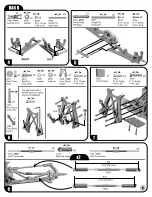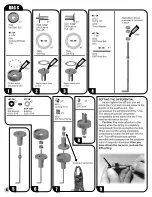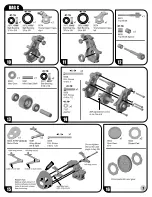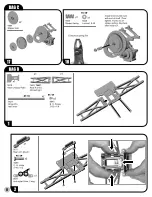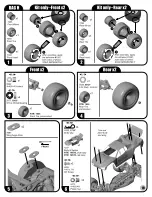
FINAL ADJUSTMENTS
RADIO ADJUSTMENTS
Use the following steps to make the final ad-
justments on your car.
1.
Turn the transmitter on.
2.
Make sure the motor is disconnected.
3.
Connect your battery pack and turn the
power switch on.
4.
Move the steering control on the transmitter
to the right and left. Do the wheels move in the
correct direction? If not, you must reverse the
steering servo direction on your transmitter (see
radio manual.)
5.
Adjust your steering trim (see radio manual)
until the #9659 steering rack is centered un-
der the top plate. Then, using the two steering
turnbuckles, adjust the front wheels so they
are pointing straight ahead.
6.
Adjust the ESC (electronic speed control)
according to the speed control manufacturer’s
instructions.
Some manufacturers have the
motor connected during adjustment and some
do not.
Now turn the power switch off.
7.
Connect the motor. Place your car on a block
or car stand so that all four wheels are elevated.
Turn the power switch on again. Check the ESC
and steering settings you have made and then
turn the power switch back off.
8.
Remember this! The transmitter is always
the
FIRST TO BE TURNED ON
and
THE
LAST TURNED OFF.
Make these adjustments before you drive the truck
MOTOR GEARING
To get the most from your motor, proper gear-
ing is important. The gear ratios listed in the
chart are recommended starting gear ratios.
Ratios can vary from track to track, but you
should not change the pinion size more than
one tooth from the recommended ratio.
FINAL
MOTOR
PINION SPUR DRIVE RATIO
24° stock (torque-based)
20
87
11.31:1
24° stock (RPM-based)
19
87
11.91:1
19 turn
19
87
11.91:1
14 turn modified motor
22
87
10.28:1
13 turn modified motor
21
87
10.77:1
12 turn modified motor
20
87
11.31:1
11 turn modified motor
19
87
11.91:1
10 turn modified motor
18
87
12.57:1
MAINTENANCE
Follow these steps to keep your truck in shape for racing
CHECK FOR FIT
You should periodically check all the moving
parts: front and rear end, suspension arms,
steering blocks, steering linkage, shocks, and
so on. If any of these should get dirty or bind
then your car’s performance will suffer.
MOTOR MAINTENANCE
Between runs, inspect the brushes to ensure
they are moving freely in the brush holder. This
is done by carefully removing the spring and
sliding the brush in and out of the holder. If there
is any resistance or rough spots, remove the
brush and carefully wipe the brush clean. This
will clean off any buildup so the brush slides
smoothly in the brush holder.
After every 3 to 5 runs, remove the brushes
from the holders and inspect the tips for wear
and/or burning. If there is a noticeable amount
of wear, replace the brush with a new pair. If
the tip is a burnt blue color, then the lubricant
in the brush has been burned away and new
brushes should be installed.
After every other battery charge you should
carefully clean the motor. One recommended
method is to spray motor cleaner directly on
the brush and commutator area. Run the mo-
tor for approximately 15 seconds. Disconnect
the motor and spray it again, making sure the
runoff is clear and clean. If the runoff is still dirty,
repeat the spraying action until clean. After com-
pleting the cleaning, apply a small amount of
lightweight oil to each bushing or bearing for
lubrication. Be careful not to apply too much
oil, for this will pick up dirt and contaminate the
commutator and brushes.
20
ASSEMBLE BATTERY PACK
If you are not using a stick battery pack, here is
how to assemble your battery pack. Solder in-
dividual cell connections as shown.
Team racers prefer battery bars for stur-
dier connections. Insulated wire will not allow
the pack to fit in the battery slot.
Solder connections with battery bars
(#651)
DIFFERENTIAL
Adjust the differential (“diff”) as noted on page
6. Adjusting the diff is not meant to be a tuning
option. If you can hear the diff making a “bark-
ing” or “chirping” sound on jump landings, ei-
ther your diff is set too loose or your slipper
clutch is set too tight. First check your slipper
setting, then re-set the diff according to the in-
structions on step C-9.
SLIPPER CLUTCH
The assembly instructions give you a base
setting for your clutch. Turn the nut on the
shaft so that the end of the top shaft is even
with the outside of the nut. Tighten the nut 3
more turns. At the track, tighten or loosen the
nut in 1/8 turn increments until you hear a
faint slipping sound for 1-2 feet on takeoffs.
Another popular way to set the clutch is
to hold both rear tires firmly in place and
apply short bursts of throttle. If the clutch is
properly set, the front tires should lift slightly
up off the surface.
Aim negative lead toward the front
CAUTION!
Increasing the
pinion size by more than one tooth
can damage your motor from ex-
cess heat.


